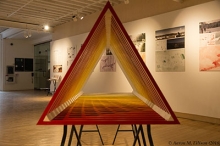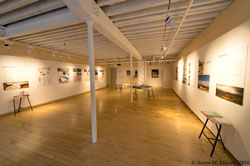You are here
Science-Art Collaboration on the Road: Shifting Sites at RISD

HF Bullard Fellow David Buckley Borden and Senior Ecologist Aaron Ellison took their collaborative exhibit, Hemlock Hospice, and a study model for a new sculpture, Warming Warning Walk, to the Rhode Island School of Design (RISD) as part of a group exhibition in March 2018.
Shifting Sites, hosted by in the RISD Department of Landscape Architecture, featured work from three award-winning practices highlighted by the department's 2017-2018 lecture series. The exhibit was curated by RISD Assistant Professor Karli Molter, who selected work by Buckley Borden and Ellison, as well as Lateral Office and Snøhetta. Collectively, the artists' work examined a wide range of site typologies, from natural remote landscapes to sensitive ecological forests, to dense urban public space and artificially created land. The projects looked at different attitudes and approaches to the diverse and complex sites seen through the lens of artists, designers, writers and engineers.
At the core of these projects were four defining questions:
- How does one look at and frame an understanding of a site?
![[Artist David Buckley Borden Loading Work for Exhibit]](/sites/default/files/RISD-opening2.jpg)
- What are the multiple scales at which we approach a site?
- How can design be used as a tool to reveal an underlying condition, or uncover the layered narratives of a site?
- How does the design of something new integrate with or interact with the existing site conditions?
All work on the exhibit depended on a cross-disciplinary approach to answering these questions. Engineers, scientists, artists, community groups, and both governmental and non-governmental agencies each understand "site" in fundamentally different ways.
Often collaborations like these require questioning disciplinary assumptions, says Borden, which can lead to the co-production of new knowledge. He noted that these collaborations can also allow for projects to gain a deeper understanding and therefore a more meaningful response to the complex layered social, ecological, and political landscapes that landscape architects work within.

- Explore Borden and Ellison's work on the Hemlock Hospice at Harvard Forest.

